QR code, or Quick Response code, is a two-dimensional barcode that can be scanned with a smartphone or QR code reader to quickly obtain information. QR code can store various data types, such as URLs, contact information, text, etc. It is now used in various fields such as marketing, retail, and logistics. QR codes are divided into two types: static and dynamic QR codes. Today we will mainly focus on static vs dynamic QR code, so that you can understand the difference between static QR codes and dynamic QR codes.
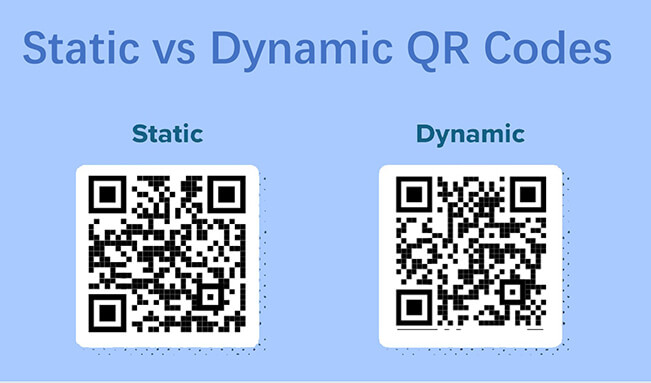
- Part 1. What Is a Static QR Code
- What Types of QR Codes Are Static?
- Pros and Cons of Static QR Codes
- How to Generate a Static QR Code
- Part 2. What Is a Dynamic QR Code
- Common Uses of Dynamic QR Codes
- Pros and Cons of Dynamic QR Code
- How to Generate a Dynamic QR Code
- Part 3. Static vs Dynamic QR Code: Key Differences
- Part 4. How to Know If QR Code Is Static or Dynamic?
- Part 5. When Should You Use Dynamic QR Codes?
- Part 6. FAQs about Static vs Dynamic QR Codes
Part 1. What Is a Static QR Code
Before we explain dynamic vs static QR code, we will clarify them separately. Static QR codes contain non-editable information. The information is encoded directly into their pattern of squares and dots. Unlike dynamic QR codes, they do not use a redirection mechanism. Once created, the information in a static QR code remains unchanged.
View also: How Static QR Codes Maximize Your Business
1.1 What Types of QR Codes Are Static?
Static QR codes contain fixed information that you cannot change after generating the code. Here are some common types of static QR codes:
URL QR Codes: These QR codes contain a static URL and direct users to a specific website. Once generated, the URL cannot be modified.
Text QR Codes: These QR codes encode plain text. The information embedded in the QR code remains the same unless a new code is generated.
Contact QR Codes: These codes store contact information (vCard). They do not change as they are static.
Wi-Fi QR Codes: When connected to a Wi-Fi network these codes contain the SSID and password for Wi-Fi networks that they connect to. The network details remain the same until a new QR code is generated.
Location on Google Maps: Displays the location on Google Maps.
Calendar Event: Instructs users to save an event (complete with information) to their phone calendar.
Phone Number: Instructs the user to dial the number
Email: Open the mail program and enter your email address in the recipient area.
1.2 Pros and Cons of Static QR Codes
Static QR codes have a lot of pros and cons as well. Let's check them out:
- Cost Effective: Static QR codes are generally generated for free and do not require a subscription.
- Offline Scan Possible: Static QR codes can be scanned offline.
- High Information Storage Capacity: Static QR codes have a higher information storage capacity than dynamic QR codes.
- Straightforward To Make: Creating a static QR code only takes a few minutes.
- High Scan Success Rate: Since static QR codes do not rely on an internet connection, static QR codes have a higher scanning success rate than dynamic QR codes.
- Not Editable: You cannot edit a static QR code after it is generated. You must generate a new QR code to change the information.
- No Scan Location Tracking Capability: You cannot track where a static QR code was scanned.
- No Analytics: Static QR codes do not offer various analytics features, such as scan time, date, location, etc.
- Little Customization: Static QR codes offer limited customization options.
1.3 How to Generate a Static QR Code
Creating and managing QR codes can take time and effort, especially for businesses looking to leverage their potential. And, choosing between static QR code VS dynamic can add to that complexity.
But that's where the iMyFone QRShow comes in. This powerful QR code solution has been designed to simplify the process by allowing you to create both types of QR codes on the same platform.
- Generate unlimited static QR codes for free
- Create and track dynamic QR codes
- Various QR codes are supported like text, vcard, social media, Email, website, etc.
- Customize the frame, logo, color, template, or other QR codes
Step 1: Go to QRShow's website and click 'Sign in/up' at the top right to sign up your QRShow account. Then click 'Dashboard' to go to QRShow's web version.
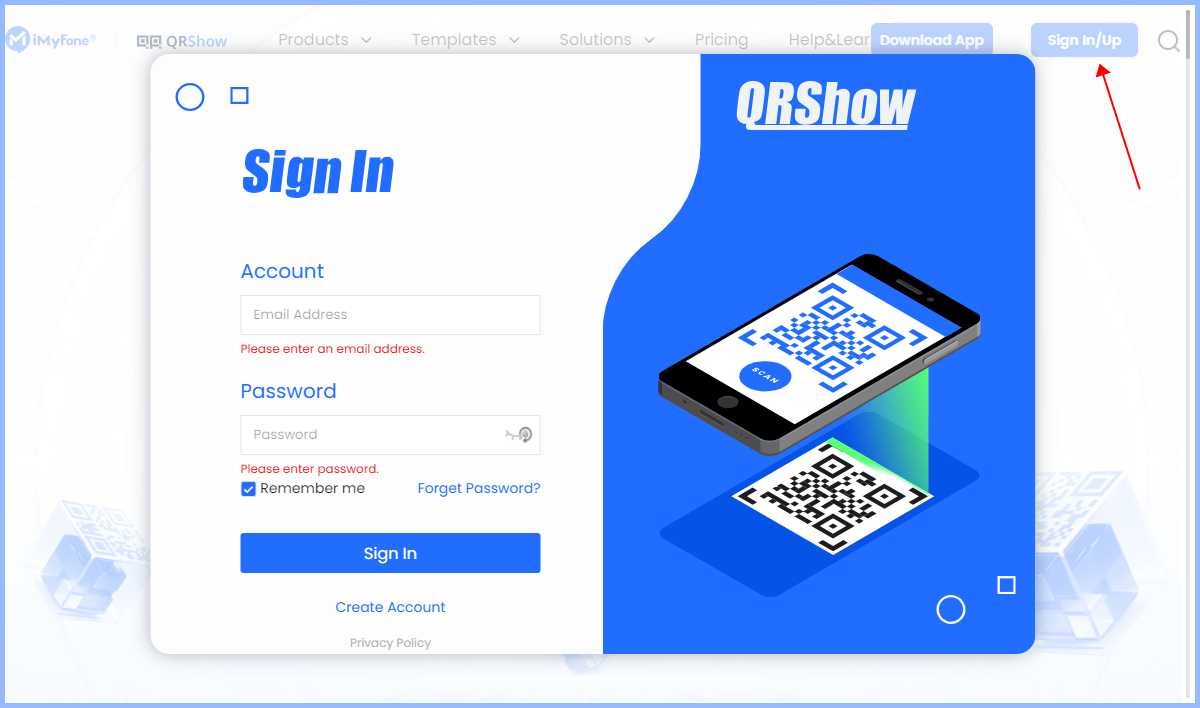
Step 2: Click 'Create QR code' and select 'Static QR code'. Then choose the type you want to generate.
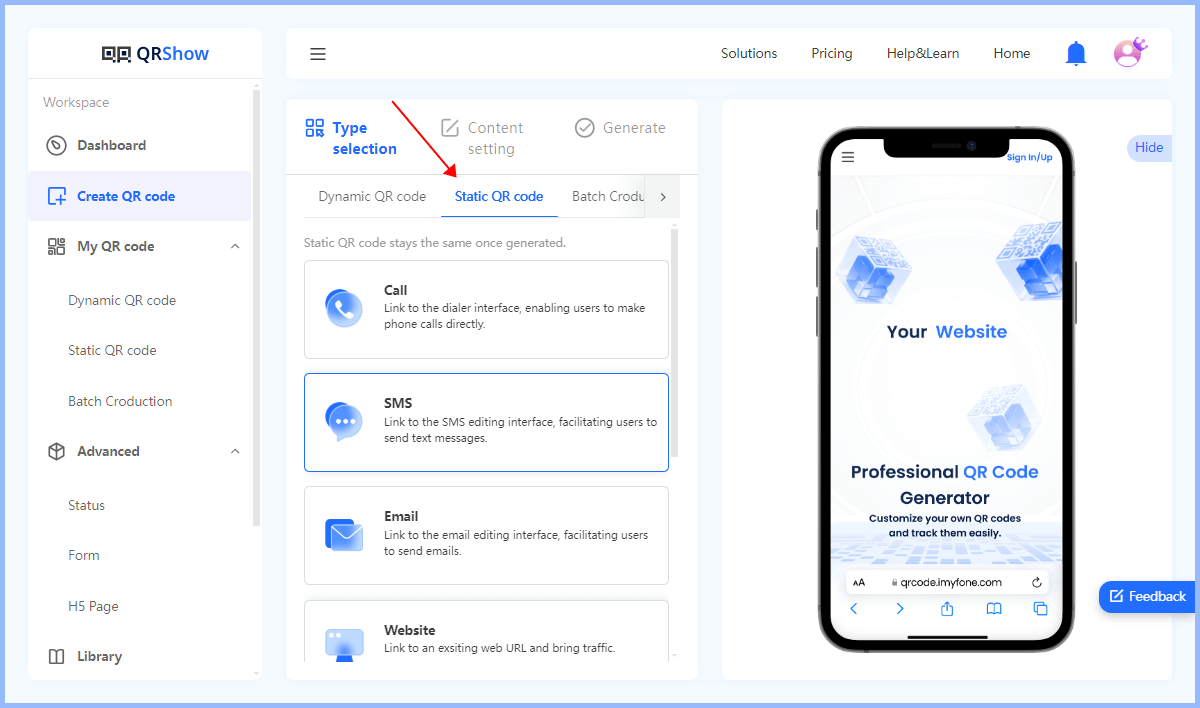
Step 3: Then upload your content and name it. For example, if I choose 'Website', I need to copy and paste my URL into it and then name the QR code.
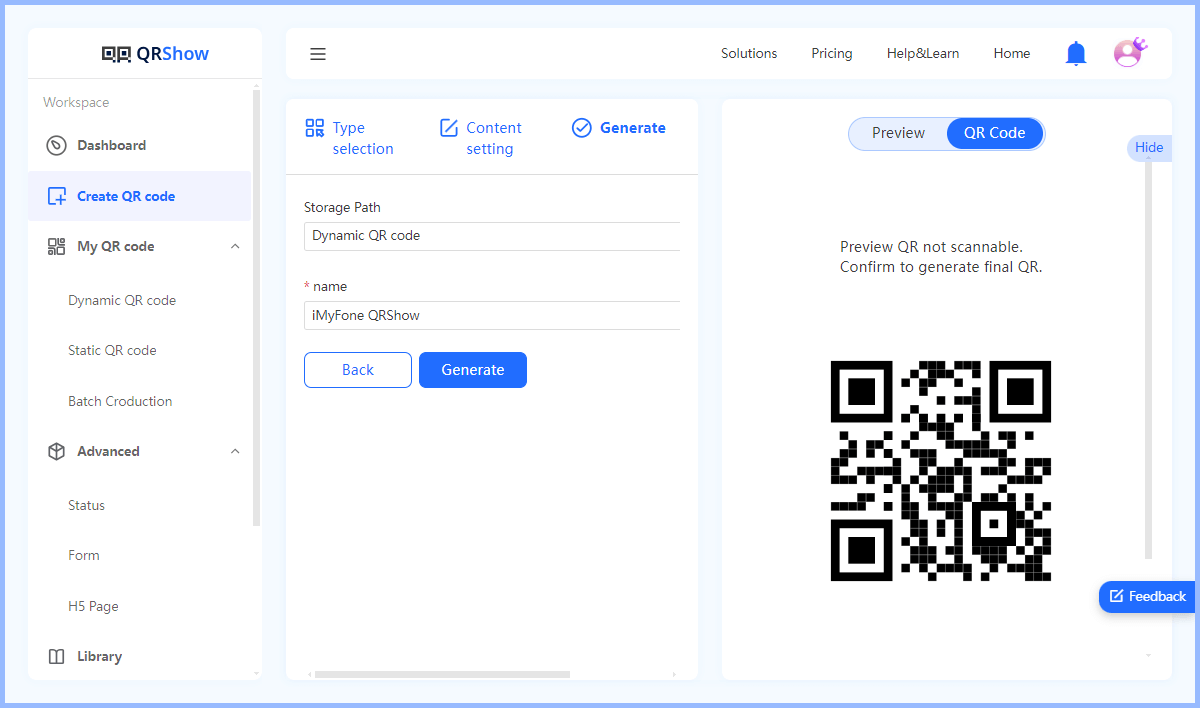
Step 4: You have the option to customize your QR code. Finally, you can click 'Generate QR Code' to create a static QR code.

Part 2. What Is a Dynamic QR Code
Dynamic QR codes are an innovative type of QR code. They offer easy modification without the need to create a new code. This remarkable flexibility empowers businesses to effortlessly update the content linked to the code without altering the code itself.
2.1 Common Uses of Dynamic QR Codes
Dynamic QR codes can be used for a wide range of purposes, including URLs, vCards, files, app downloads, social media, WiFi, events, coupons, and more. You can use dynamic QR codes whenever you want to re-edit the QR code content later. Here are some of the uses for QR codes.
Marketing Campaigns: You can analyze the effectiveness of different campaigns by updating marketing content such as promotional offers.
Product Information: Generally, products will have updates and iterations, so dynamic QR codes allow you to provide consumers with updated product details, user manuals, etc. at any time.
Digital Menus: Restaurants can update menus, prices, etc. without reprinting physical menus.
Contact Information: You can share the latest contact information, including phone numbers, email addresses, etc.
Educational Materials: Teachers or educational institutions can provide students with the latest course materials, publish homework, etc.
Healthcare: Hospitals can use dynamic QR codes to provide patients with medication information, appointment information, etc.
2.2 Pros and Cons of Dynamic QR Code
Just like static QR code, dynamic QR codes have some pros and cons as well. Here are some notable pros and cons of dynamic QR codes:
- Editable: You can edit dynamic QR codes very easily without having to create new ones.
- Tracking: Dynamic QR codes provide tracking information such as scan location, time, and device used.
- Customization: Dynamic QR codes provide customization options such as changing the color and design of the code.
- Versatility: Dynamic QR codes can deliver various types of content, including text, images, and videos.
- Subscription Costs: Generally, you may need to subscribe to a QR code service to create and manage dynamic QR codes.
- Limited Scan Capacity: Dynamic QR codes may have a maximum scanning limit, depending on the service provider.
- Reliance on Internet Connectivity: Dynamic QR codes require a stable Internet connection to function properly.
- Security Concerns: Dynamic QR codes are vulnerable to hacking because the content behind the code can be changed at any time.
2.3 How to Generate a Dynamic QR Code
In fact, the steps to generate a dynamic QR code are similar to those of a static QR code. The only difference is that you need to select the dynamic QR code option in the iMyFone QRShow. We will not go into detail here.
Step 1: Launch QRShow and choose 'Create QR code?' > 'Dynamic QR code'. Then upload your content and generate a QRcode.
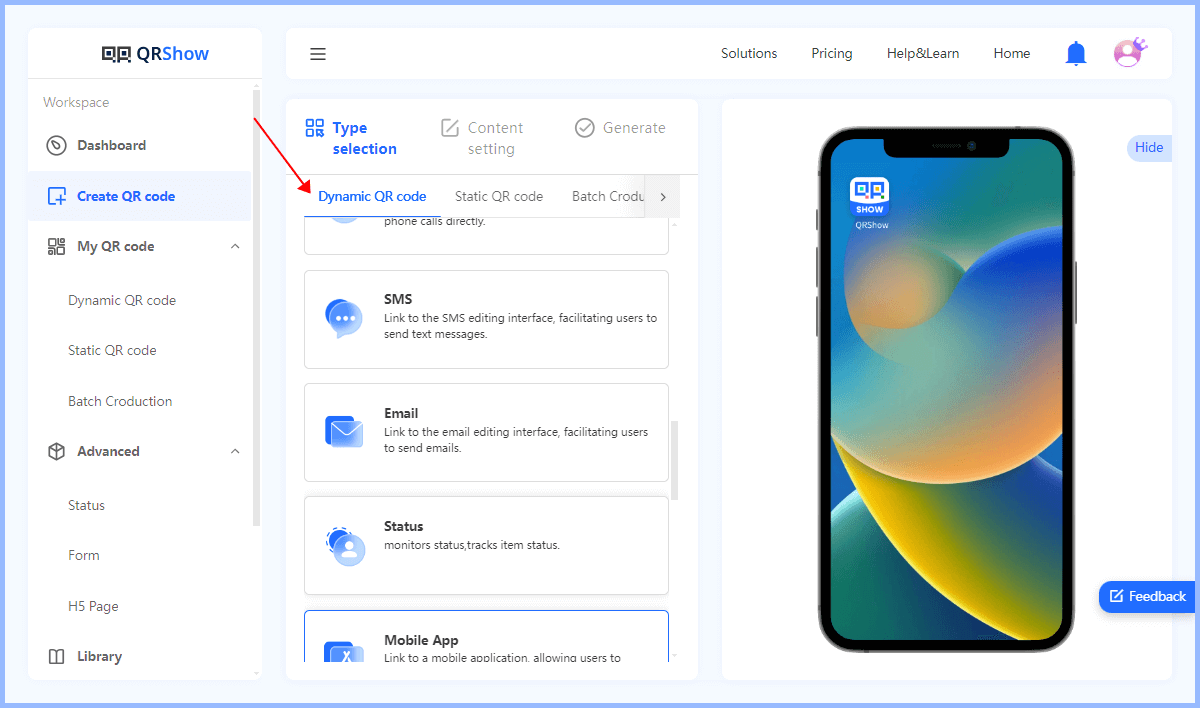
Step 2: After generating a QR code, you can track the scan time, location, operating system, and more. To analyze your QR code scans, go to 'My QR code' and find the QR code you want to check (only dynamic QR code can be tracked). Then click the 'Statistics' icon and you can check all scan data.
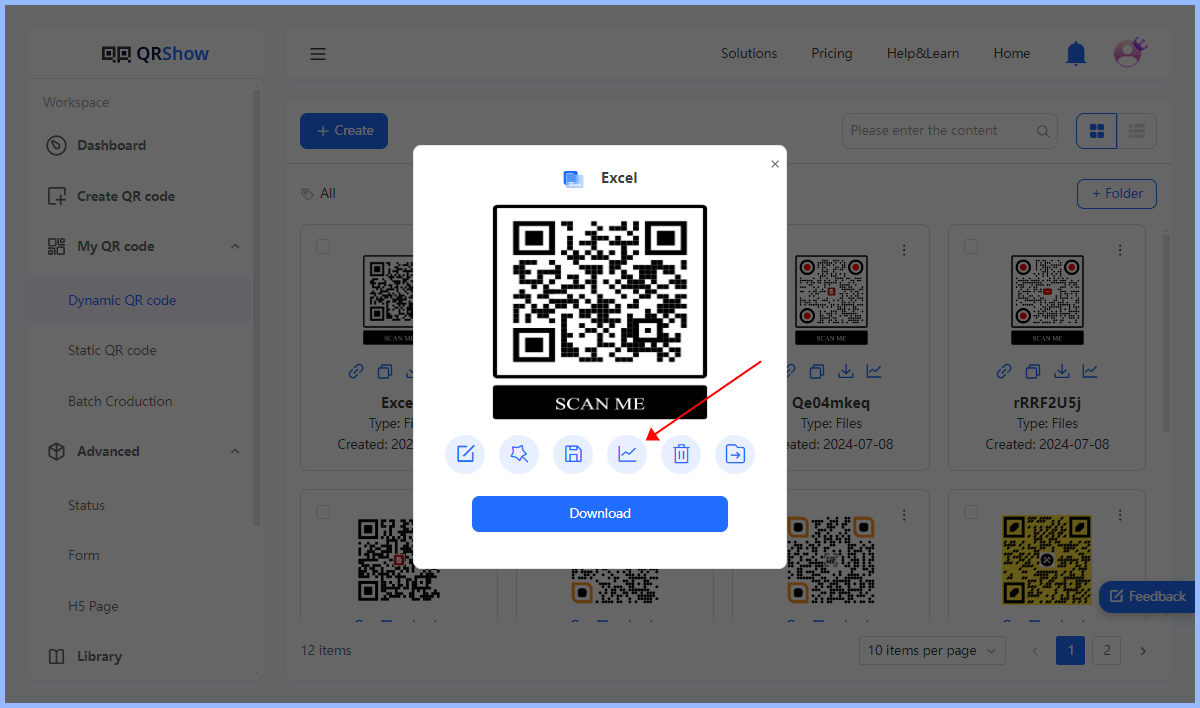
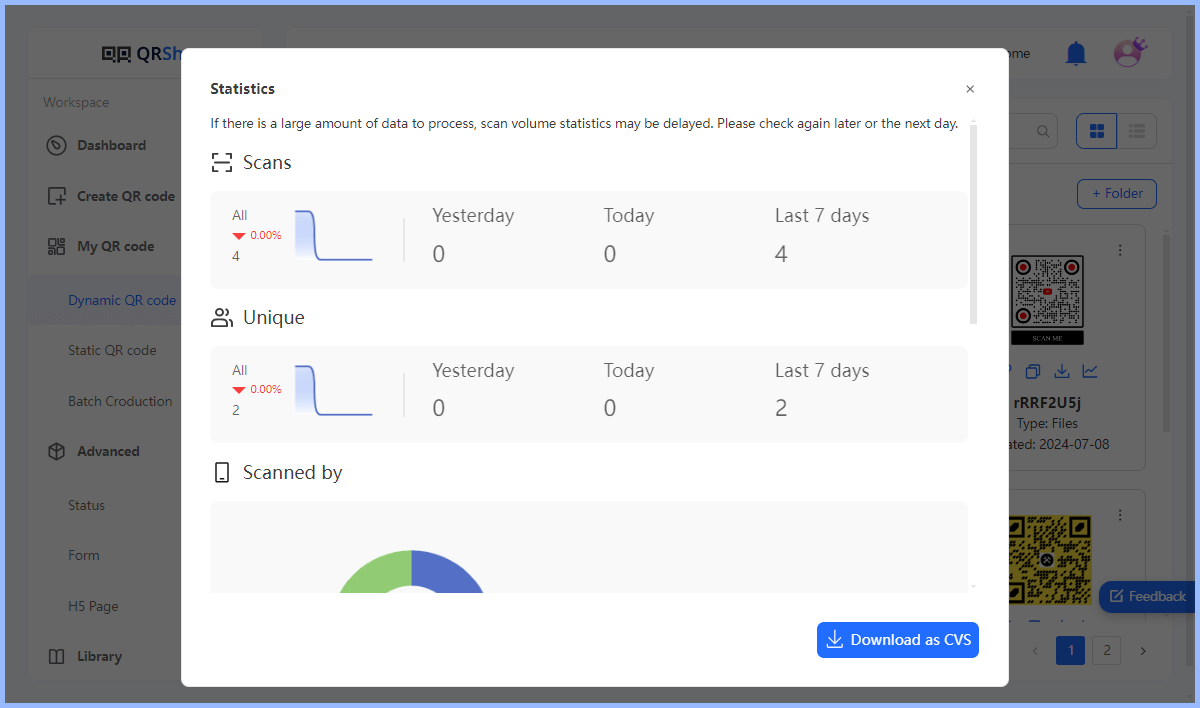
Part 3. Static vs Dynamic QR Codes: Main Differences
What is the Difference between static and dynamic QR codes? Dynamic and static QR codes have their own advantages and disadvantages, use cases and quite a lot of differences. The following table denotes the key difference between static and dynamic QR code:
| Features | Static QR Codes | Dynamic QR Codes |
|---|---|---|
| Data Type | Fixed data. | Dynamic data. |
| Functionality | Limited functionality. | Versatile. |
| Ability to Track | ❌ | ✅ |
| Ability to Modify | ❌ | ✅ |
| Ability to Shorten URLs | ❌ | ✅ |
| Ability to Generate in Bulk | ❌ | ✅ |
| Use Cases | Basic information sharing, e.g., linking to website contact details. | Dynamic content scenarios, e.g., promotions, ticketing, inventory tracking. |
| Reliability | Reliability in situations where the information is static. | Dependent on a platform for updates; may require internet connectivity. |
| Generation & Management | Simple to generate and manage; no ongoing updates needed. | It may require access to a management platform for updates, potential subscriptions, or costs. |
| Analytics | Limited or no analytics features. | Enhanced analytics, such as scan counts and location data. |
Part 4. How to Know If QR Code Is Static or Dynamic
It's hard to tell if a QR code is static or dynamic just by looking at it. But you can tell in the following ways.
1. Check the QR Code Generator Tool
Generally, the QR code generator will clearly show the type of QR code you are generating. iMyFone QRShow clearly divides the QR codes you generate into static and dynamic ones, so you can easily distinguish them.
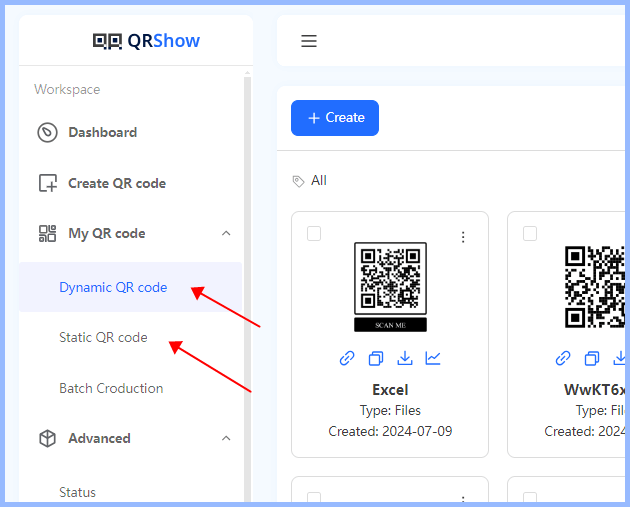
2. Scan the QR Code
Scan the QR code to see if it points to a redirect or directly to the target content. A redirect is a dynamic QR code, and a direct QR code is a static QR code.
The URL structure of a static QR code: https://www.example.com/page
The URL structure of a dynamic QR code: https://qr.example.com/redirect?id=12345
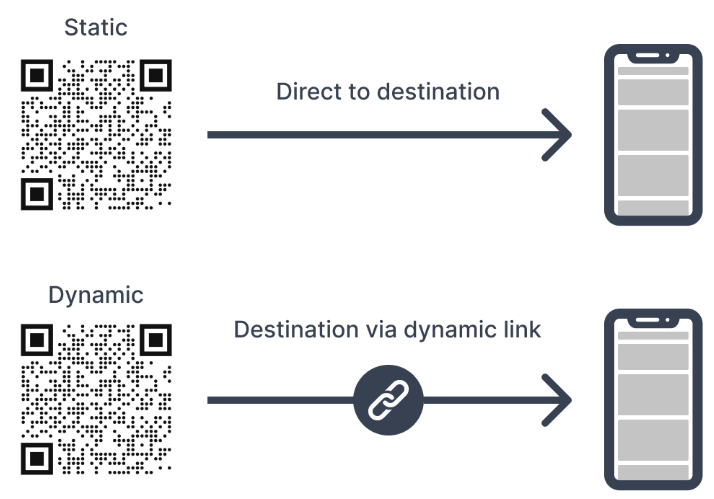
3. Check the Tracking Feature
Dynamic QR codes usually have tracking and analysis features. If the QR code provides scan tracking and analysis features, it is likely a dynamic QR code.
4. Use a QR Code Management Platform
Some QR code management platforms provide tools to analyze and manage QR codes. These platforms can help you determine whether a QR code is static or dynamic.
Part 5. When Should You Use Dynamic QR Codes
Simply put, dynamic QR codes are the first choice when the target app or website needs to change. Static QR codes always display the same information, ensuring a reliable and consistent user experience.
- Need frequent updates
- Need tracking and analytics
- Avoid reprinting
- Want to personalize content
- Want to engage users with interactive content
- Permanent information
- Limited budget
- Simple, direct solution without tracking or analytics
- Quick access to information without intermediary services or redirects
- Avoid potential security risks associated with dynamic QR codes
- Offline use
FAQs
No, a dynamic QR code cannot be converted to a static QR code, and a static QR code cannot be converted to a dynamic QR code. They are two different types of QR codes with technical differences and cannot be converted to each other.
However, if you want, you can first determine the content that the dynamic QR code redirects, and then use a QR code generator tool to recreate a new static QR code. You can use iMyFone QRShow to convert. Just find the content you want to convert, and then choose to regenerate it as a static or dynamic QR code.
No. Static QR codes do not have built-in tracking capabilities and therefore cannot display total scan counts. To track QR code scans, you will need to create a dynamic QR code.
Conclusion
Understanding the differences between dynamic QR code VS static is essential for harnessing the full potential of QR code technology. Ultimately, the choice between static and dynamic QR codes depends on the specific needs and objectives of your business or marketing campaign.






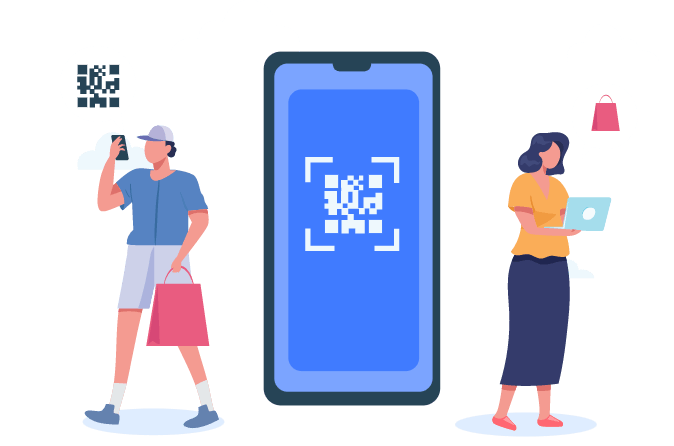


Rated Successfully!
You have already rated this article!